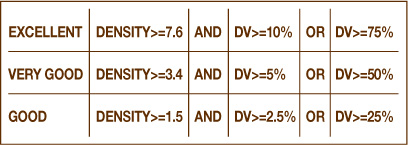
In order to quantify the nutrient richness of each of the World’s Healthiest Foods in both this book and the www.whfood.org website, a team of top nutritionists and I designed the World’s Healthiest Foods Quality Rating System (“Rating System”).
This Rating System qualifies foods as “excellent,” “very good” and “good” sources of nutrients, providing you with a simple, yet reliable, way to determine the nutritional attributes of a food. These quality descriptions don’t just take a food’s nutrient contribution into consideration; rather, they evaluate this nutrient contribution in relationship to the amount of calories a food contains. This way you can evaluate foods in terms of their ability to maximize your intake of important nutrients without having to exceed your individual caloric intake goals. (For more on the importance of nutrient richness, see page 24.)
To help you better understand the categorization of foods as “excellent,” “very good” or “good” sources of a particular nutrient, I want to provide you with some background as to how these quality ratings were derived.
We began with a computerized analysis of the nutritional con tents of the World’s Healthiest Foods using the nutritional analysis software, Food Processor for Windows (ESHA Research, Salem, Oregon, USA). In other words, we started with a food like spinach, and we analyzed how much vitamin C, vitamin A, zinc, protein, etc. that food contained in one commonly eaten serving.

For each food we found the %Daily Value (DV) contribution of each nutrient, as well as the food serving’s %DV contribution of calories (for more on DV, see below); the comparison of the two became the Density, and is the first (and most important) part of the formula to determine the food’s quality rating. We then picked a simple, three-category system for rating all foods: “excellent,” “very good” and “good.” The definitions of these rating qualifications are shown in the chart on the previous page.
In reality, the goal that each individual should strive for in terms of daily nutrient and caloric intake varies depending upon his or her personal needs. Yet, to help individuals meet their nutritional needs, government agencies have created standard recommendations for intake. The most up-to-date ones in the U.S. are those created by the Institute of Medicine and are known as the Dietary Reference Intakes (DRIs). Yet, since these DRIs can have many values for each nutrient (varying by age, gender and whether a woman is pregnant or lactating), we chose not to use these as our Daily Value (DV) standard. Rather, for most nutrients we chose to use the U.S. Food and Drug Administration’s “Reference Values for Nutrition Labeling” as our standard for DVs. These are the values used by food manufacturers in the “Food Facts” portion of their product’s label.
For other nutrients, for example for those where there were no “Reference Values,” we derived a DV based upon the latest research or opinion of nutrition science experts. For example, we chose 2.5 grams as the Daily Value for omega-3 fatty acids; this was derived from recommendations of a panel of experts at a workshop sponsored by the National Institutes of Health in 1999, including Artemis Simopoulos, MD, Alexander Leaf, MD, and Norman Salem, Jr., Ph.D., who concluded that at least 1.2% of total calories should consist of omega-3 fatty acids. Since we used 1,800 calories as the reference diet for the Rating System, this translated into the 2.5 grams per day of omega-3 fatty acids that we chose for this nutrient’s DV. The 1,800 calories chosen as the reference diet is based upon the Institute of Medicine’s recommendation for sedentary women, age 31-50.
Once the density ratings for each food were calculated, I wanted to create a quantitative way that each food’s density could be compared. This was the number that was to become the Total Nutrient Richness, featured in each of the Nutrient Richness Charts as well as the Total Nutrient Richness Chart on page 21. The number is a reflection of how many “excellent,” “very good” and “good” ratings a food had. Each “excellent” was assigned a value of 4, each “very good” a value of “2” and each “good” a value of 1. These were added together to arrive at the Total Nutrient Richness score.
In addition to the Nutrient Richness Chart featured for each food, each food chapter also includes a nutritional analysis that contains information on the amounts of over 60 nutrients that may be featured in that food. In addition to providing the amount of the nutrient, it also provides the %DV for many nutrients (some nutrients do not yet have established DVs).
As noted above, the nutrient profiles are derived from Food Processor for Windows software by ESHA Research. Of the 21,629 food records contained in the ESHA foods database, most of them—including those of the World’s Healthiest Foods—lacked information for specific nutrients. In the nutritional analysis chart for each food, the designation “—” was chosen to represent those nutrients for which there was no measurement included in the ESHA foods database.
Data on phytonutrient values in an individual food’s Nutrient Richness Chart were derived from the USDA National Nutrient Database for Standard Reference, Release 17 (2004) (http://www.nal.usda.gov/fnic/foodcomp/search) and the USDA Nutrient Data Laboratory, Agricultural Research Ser-vice. USDA Database for the Flavonoid Content of Selected Foods–2003 (http://www.nal.usda.gov/fnic/foodcomp/Data/Flav/flav.html). Oftentimes, information on phytonutrients may be cited in the text of individual food chapters without values appearing in the Nutrient Richness Chart; that is because there were either no measurements or no appreciable measurements for these phytonutrients featured in these databases.